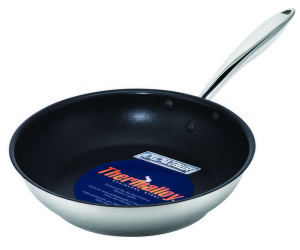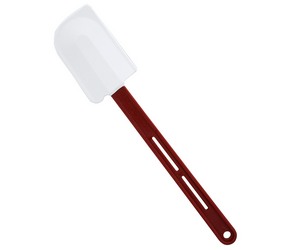As with most products in the restaurant industry, when it comes to cookware, there are a variety of manufactures, materials, and designs to choose from, including coatings. With all of these options, the task of shopping for cookware may seem daunting. Do not be discouraged. In this blog series, our aim is to equip you with the product knowledge you need to select the best cookware to meet your specific needs.
Nonstick
We will begin our discussion with nonstick coatings, which may be found on a variety of cookware, but are most often featured on skillets. There are a number of benefits to nonstick coatings. Nonstick pans are easy to clean, saving time in the kitchen. They require little to no oil or butter during the cooking process, which means added health benefits and cost savings. Nonstick pans make some cooking techniques such as sautéing, egg cookery, or even plating much more effortless. However, this does not mean that nonstick cookware is applicable in every cooking scenario. For example, when searing or braising a cut of meat, many chefs like to use the “fond” (the flavor-packed bits that stick to the bottom of a standard pan) to make a quick pan sauce using the deglazing technique. Stock or wine is poured into the bottom of the still-hot pan, loosening the fond and incorporating it into the deglazing liquid. This liquid is then reduced or thickened to make a sauce. The releasing properties of a nonstick pan create little to no fond at all, and thus, no pan sauce. Many cooks and chefs also prefer standard pans over nonstick for searing meats such as steaks or scallops.
Quality
Not all nonstick coatings are created equal. The two most common types of nonstick material are silicone and fluoropolymer. Most nonindustrial nonstick pans use only one or two coats of nonstick material – typically silicone – which tends to lose its nonstick properties much sooner than more resistant fluoropolymers. Industrial nonstick pans use additional coats of fluoropolymer nonstick as well as reinforcing agents made up of tiny particles such as stainless steel or ceramic. These agents protect the nonstick coating from wear and scratches. The best quality coatings will feature three coats; a primer, a mid-coat, and a topcoat with reinforcing agents sprayed in between.
These professional coatings range in quality from good, to better and best. For example, in the good category, we have Vollrath’s Wear-Ever® aluminum pans with Vollrath’s Power Coat 2® coating. It features a dual fluoropolymer coat with ceramic reinforcing agents, providing great release properties and wear resistance. In the better category, we have Browne Foodservice’s Thermalloy® aluminum pans with Eclipse® nonstick coating. Eclipse® features a three-layer internally-reinforced coating, delivering superior food release quality and scratch resistance. These pans also feature removable, heat resistant handle sleeves, giving you the option to move your product from the stovetop to the oven for finishing. In the best category, we have Browne Foodservice’s Thermalloy® Tri-ply stainless steel pans with Excalibur® nonstick coating. Tri-ply pans have an internal layer of aluminum, seamlessly bonded between two layers of stainless steel for increased heat conduction. Excalibur® uses three coats of fluoropolymer nonstick for superior release and is reinforced with stainless steel particles for scratch resistance. These pans also feature hollow cast, stainless steel stay-cool handles.
Care
Certain preventative measures can be taken to prolong the lifetime of your nonstick cookware. First of all, you want to avoid using excessive heat with your non-stick cookware. If you are preparing a recipe that requires very high heat, consider using a pan without nonstick. Also, do not leave an empty pan sitting over an active heat source. Doing so can distort the pan and harm the nonstick coating. If you are heating water or cooking fat, add it prior to heating the pan. Second, try to avoid unnecessary scratching of the nonstick surface. Consider using nonmetallic utensils like wooden spoons or silicone high heat spatulas. Third, always allow your cookware to cool before immersing it in water to prevent warping pan and damaging the nonstick coating. Finally, when it comes to cleaning your nonstick, washing by hand is always best. Commercial dish machines use chemicals that can be harsh on the nonstick surface. If your nonstick cookware has burned-on of built-up food particles or grease, these can be removed with hot, soapy water using a mild detergent and a non-abrasive tool such as a dishtowel. If you follow these simple precautions, you will greatly increase the lifetime of your nonstick cookware.
PFOA
In recent years, there has some concern and confusion over adverse health effects in humans related to perfluorooctanoic acid (abbreviated PFOA), a bonding agent used in the manufacture of various fluoropolymers. PFOA is not to be confused with polytetrafluoroethylene (abbreviated PTFE), the fluoropolymer nonstick material. Whatever the health concerns over the use of PFOA may be, the fact is that PFOA is destroyed in one second at 500° F, and high-quality nonstick coatings are all cured at very high temperatures, usually around 800°F for ten minutes. So the conditions are such that the PFOA is destroyed in the curing process. In other words, it is absolutely safe to use nonstick cookware even if PFOA was used in the manufacturing process. Still, the Environmental Protection Agency called for the reduction of the use of PFOA by 95% by the year 2010, and the virtual elimination of PFOA by the year 2015. As a result of these changes, to date, PFOA has indeed been virtually eliminated in the manufacturing process of nonstick cookware, and all of the cookware we sell at Dine Company is PFOA free.



